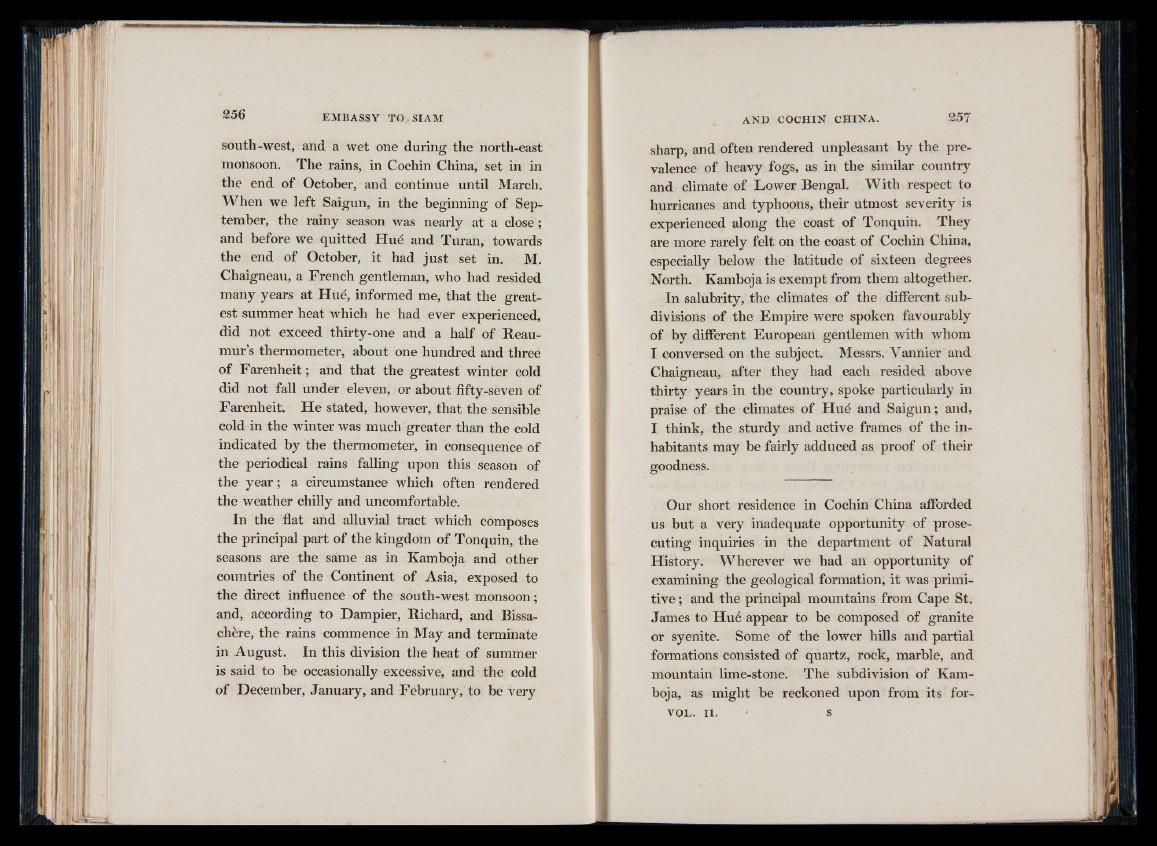
south-west, and a wet one during the north-east
monsoon. The rains, in Cochin China, set in in
the end of October, and continue until March.
When we left Saigun, in the beginning of September,
the rainy season was nearly at a close ;
and before we quitted Hué and Turan, towards
the end of October, it had just set in. M.
Chaigneau, a French gentleman, who had resided
many years at Hué, informed me, that the greatest
summer heat which he had ever experienced,
did not exceed thirty-one and a half of Reaumur’s
thermometer, about one hundred and three
of Farenheit; and that the greatest winter cold
did not fall under eleven, or about fifty-seven of
Farenheit. He stated, however, that the sensible
cold in the winter was much greater than the cold
indicated by the thermometer, in consequence of
the periodical rains falling upon this season of
the year ; a circumstance which often rendered
thé weather chilly and uncomfortable.
In the flat and alluvial tract which composes
the principal part of the kingdom of Toriquin, the
seasons are the same as in Kamboja and other
countries of the Continent of Asia, exposed to
the direct influence of the south-west monsoon ;
and, according to Dampier, Richard, and Bissa-
chère, the rains commence in May and terminate
in August. In this division the heat of summer
is said to be occasionally excessive, and the cold
of December, January, and February, to be very
sharp, and often rendered unpleasant by the prevalence
of heavy fogs, as in the similar country
and climate of Lower Bengal. With respect to
hurricanes and typhoons, their utmost severity is
experienced along the coast of Tonquin. They
are more rarely felt on the coast of Cochin China,
especially below the latitude of sixteen degrees
North. Kamboja is exempt from them altogether.
In salubrity, the climates of the different subdivisions
of the Empire were spoken favourably
of by different European gentlemen with whom
I conversed on the subject. Messrs. Vannier and
Chaigneau, after they had each resided above
thirty years in the country, spoke particularly in
praise of the climates of Hué and Saigun ; and,
I think, the sturdy and active frames of the inhabitants
may be fairly adduced as proof of their
goodness.
Our short residence in Cochin China afforded
us but a very inadequate opportunity of prosecuting
inquiries in the department of Natural
History. Wherever we had an opportunity of
examining the geological formation, it was primitive
; and the principal mountains from Cape St.
James to Hué appear to be composed of granite
or syenite. Some of the lower hills and partial
formations consisted of quartz, rock, marble, and
mountain lime-stone. The subdivision of Kamboja,
as might be reckoned upon from its for-
VOL. II. s